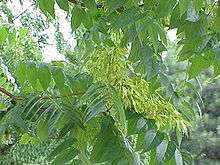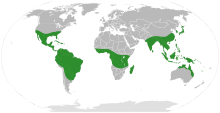Simaroubaceae
The Simaroubaceae are a small, mostly tropical, family in the order Sapindales. In recent decades, it has been subject to much taxonomic debate, with several small families being split off. A molecular phylogeny of the family was published in 2007, greatly clarifying relationships within the family.[2] Together with chemical characteristics such as the occurrence of petroselinic acid in Picrasma[3] in contrast to other members of the family such as Ailanthus[4] this indicates the existence of a subgroup in the family with Picrasma, Holacantha, and Castela.
| Simaroubaceae | |
|---|---|
 | |
| Ailanthus altissima | |
| Scientific classification | |
| Kingdom: | Plantae |
| Clade: | Tracheophytes |
| Clade: | Angiosperms |
| Clade: | Eudicots |
| Clade: | Rosids |
| Order: | Sapindales |
| Family: | Simaroubaceae DC.[1] |
| Genera | |
|
See text | |
 | |
| Distribution of the family Simaroubaceae. | |
| Synonyms | |
| |
The best-known species is the temperate Chinese tree-of-heaven Ailanthus altissima, which has become a cosmopolitan weed tree of urban areas[5] and wildlands.[6]
Well-known genera in the family include the tropical Quassia and Simarouba.
Genera
|
|
Excluded genera
|
|
References
- "Family: Simaroubaceae DC., nom. cons". Germplasm Resources Information Network. United States Department of Agriculture. 2003-01-17. Retrieved 2011-04-19.
- Clayton, Joshua W.; Edwino S. Fernando; Pamela S. Soltis; Douglas E. Soltis (2007). "Molecular phylogeny of the tree-of-heaven family (Simaroubaceae) based on chloroplast and nuclear markers". International Journal of Plant Sciences. 168 (9): 1325–1339. doi:10.1086/521796.
- Tsujimoto, M. and Koyanagi, H. (1933) Bull. Chem. Soc. Jpn. 8, 161
- T. Stuhlfauth, H. Fock, H. Huber, K. Klug: The distribution of fatty acids including petroselinic and tariric acids in the fruit and seed oils of the Pittosporaceae, Araliaceae, Umbelliferae, Simarubaceae and Rutaceae. In: Biochemical Systematics and Ecology. 13, 1985, S. 447–453, doi:10.1016/0305-1978(85)90091-2.
- http://www.hort.cornell.edu/uhi/research/articles/jeh4(1).pdf
- Knapp, Liza B; Canham, Charles D (2000). "Invasion of an Old-Growth Forest in New York by Ailanthus altissima: Sapling Growth and Recruitment in Canopy Gaps". Journal of the Torrey Botanical Society. 127 (4): 307. doi:10.2307/3088649. JSTOR 3088649.
- "GRIN Genera of Simaroubaceae". Germplasm Resources Information Network. United States Department of Agriculture. Retrieved 2011-04-19.
- "GRIN genera sometimes placed in Simaroubaceae". Germplasm Resources Information Network. United States Department of Agriculture. Retrieved 2011-04-19.
External links
![]()
![]()